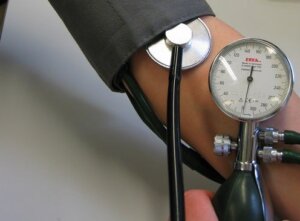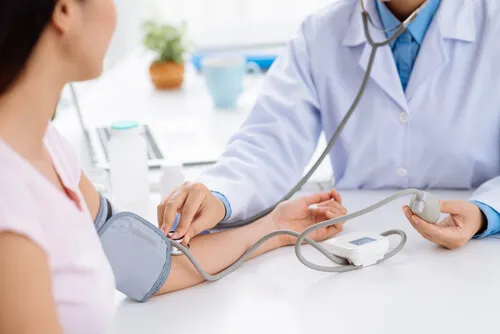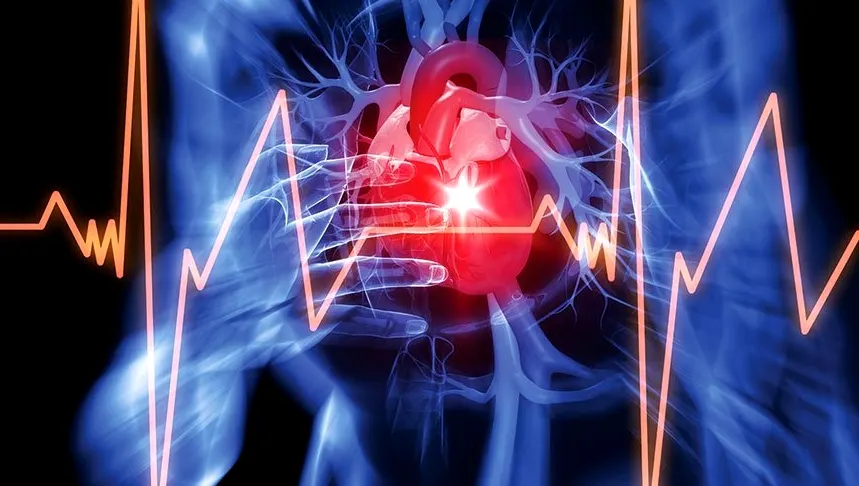Low Blood Pressure: How to Regulate it and What to Do When it Drops


Written and verified by the doctor Maricela Jiménez López
Blood pressure is nothing more than the pressure exerted by the blood on the walls of the arteries during the cardiac cycle. There are two types of blood pressure: systolic and diastolic. The former refers to the pressure that blood reaches in the arteries during contraction (systole), while the latter refers to the pressure of blood during cardiac relaxation (diastole).
Pressure changes are normal. For example, blood pressure rises when we exercise. This is because in these circumstances the cardiac output (the amount of blood ejected by the heart per unit of time) is higher, a consequence of greater demand for oxygen by the muscles.
A decrease in blood pressure occurs when we sleep, among other times. However, there are situations in which blood pressure remains low for a long time. In these cases, we may experience fainting, dizziness, nausea, pallor, and fatigue.
Low blood pressure or hypotension
Blood pressure is measured in millimeters of mercury (mmHg), with values between 105 and 120 for systolic pressure and 60 to 80 for diastolic pressure being normal.
Blood pressure regulation depends on the cardiovascular regulation centers of the central nervous system (CNS) and the autonomic nervous system. When the pressure is below 90/60 mmHg, we’re talking about arterial hypotension.

Hypotension, when chronic and sustained, can be life and health-altering if not controlled. It can cause dizziness and fainting. What’s more, it can lead to damage to the heart and brain due to a lack of blood supply and oxygen.
We think you may also enjoy reading this article: How to Deal with a Heart Attack if You’re Alone
What can regulate blood pressure?
Blood pressure depends on two factors: cardiac output (the amount of blood ejected by the heart per unit time) and total peripheral resistance (resistance of the vascular system to blood flow). Mechanisms that control either of these two factors can modify blood pressure.
Physiologically, blood pressure regulation depends on the cardiovascular regulatory centers of the central nervous system (CNS) and the autonomic nervous system. Both structures can send control signals to different organs.
The heart
The heart regulates its frequency and force of its beat to control the amount of blood it pumps.

The kidneys
The kidneys control the level of the water fraction in the blood. They remove excess water leading to a decrease in the amount of blood and thus blood pressure. Otherwise, they can transfer water into the bloodstream, thereby increasing the amount of blood and thus blood pressure.
Blood vessels
Blood vessels can control blood pressure by increasing or decreasing the lumen of the vascular system. This is achieved by contracting or relaxing the musculature that forms the blood vessels.
Orthostatic hypotension
This is a type of hypotension that occurs when you get up quickly from a place after having been still for a long time, as it decreases blood flow to the brain. It’s not a disease; it’s an inability to regulate pressure quickly, resulting in dizziness, slight dizziness, blurred vision, or fainting.
It sometimes occurs as an adverse reaction to certain medications, and may even be related, according to some research, to smoking.
It can also occur as a result of other conditions such as:
- Cardiac problems
- Endocrine disorders
- Nervous system diseases
- Dehydration
Like this article? You may also like to read: Heart Rate: What Is It and How Is It Measured?
What should you do when your blood pressure is low?
In general, hypotension tends to affect women and sedentary people to a greater extent, according to various studies. It’s also more prevalent in older people, especially those over 70 years of age.
If a drop in blood pressure is suspected, the following recommendations should be followed:
- Sit or lie down.
- Ask a family member, friend, or acquaintance to help you stay alert.
- Elevate your legs above your heart.
- Breathe deeply for 3 to 5 minutes.
- Drink a glass of water little by little.
If the symptoms improve in the first 30 minutes, remain calm and go for a consultation with a professional as soon as possible. In case there’s no improvement, you should seek emergency medical attention to avoid further complications.
8 tips to prevent low blood pressure
To prevent a drop in blood pressure, the following is recommended:
- Drink two to three liters of water a day (about 8 large glasses) including broths, juices, and hydrating drinks.
- Include carbohydrates at breakfast, such as cereals, bread, milk, and yogurt.
- Never start the day without food.
- Eat well and also include fruits between meals.
- Choose nutritious foods, such as fruits, vegetables, cereals, dairy products, pasta, rice, eggs, and lean meats.
- Don’t go on a diet without consulting a specialist.
- Avoid alcoholic beverages, as they dilate the blood vessels and can cause your blood pressure to drop.
- You can also consider food supplements, especially those containing ginseng, as these prevent physical and mental fatigue.
Low blood pressure shouldn’t limit your daily routine or quality of life, as it can be controlled in a very simple way. However, it’s best to first consult your doctor if you have this problem.
If you follow his or her recommendations, you won’t have any problems and will be able to lead a normal life without any setbacks.
All cited sources were thoroughly reviewed by our team to ensure their quality, reliability, currency, and validity. The bibliography of this article was considered reliable and of academic or scientific accuracy.
- Andrea Contreras, S. (2013). Sueño a lo largo de la vida y sus implicancias en salud. Revista médica Clínica Las Condes, 24(3), 341–349. https://doi.org/10.1016/s0716-8640(13)70171-8
- Estañol, B., Porras-Betancourt, M., Sánchez-Torres, G., Martínez-Memije, R., Infante, O., & Sentíes-Madrid, H. (2009). Control neural de la circulación periférica y de la presión arterial. Archivos de cardiologia de Mexico, 79, 109–116. https://www.scielo.org.mx/scielo.php?script=sci_arttext&pid=S1405-99402009000600020
- García, X., Mateu, L., Maynar, J., Mercadal, J., Ochagavía, A., & Ferrandiz, A. (2011). Estimación del gasto cardíaco: Utilidad en la práctica clínica. Monitorización disponible invasiva y no invasiva. Medicina Intensiva, 35(9), 552–561. https://scielo.isciii.es/scielo.php?script=sci_arttext&pid=S0210-56912011000900004
- Hatib, F., Jian, Z., Buddi, S., Lee, C., Settels, J., Sibert, K., Rinehart, J., & Cannesson, M. (2018). Machine-learning algorithm to predict hypotension based on high-fidelity arterial pressure waveform analysis. Anesthesiology, 129(4), 663–674. https://doi.org/10.1097/ALN.0000000000002300
- Juraschek, S. P., Taylor, A. A., Wright, J. T., Jr, Evans, G. W., Miller, E. R., 3rd, Plante, T. B., Cushman, W. C., Gure, T. R., Haley, W. E., Moinuddin, I., Nord, J., Oparil, S., Pedley, C., Roumie, C. L., Whittle, J., Wiggers, A., Finucane, C., Anne Kenny, R., Appel, L. J., … SPRINT Research Group. (2020). Orthostatic hypotension, cardiovascular outcomes, and adverse events: Results from SPRINT: Results from SPRINT. Hypertension, 75(3), 660–667. https://doi.org/10.1161/HYPERTENSIONAHA.119.14309
- MayoClinic. (n.d). Presión arterial baja (hipotensión). Mayoclinic.org. https://www.mayoclinic.org/es-es/diseases-conditions/low-blood-pressure/diagnosis-treatment/drc-20355470
- MedlinePlus. (2021). Hipotensión. https://medlineplus.gov/spanish/ency/article/007278.htm
- Piskorz, D. (2007). De la hipertensión arterial a la insuficiencia cardíaca. Insuficiencia Cardíaca, 2(3), 105–110. https://www.redalyc.org/articulo.oa?id=321927780005
- Procter, L. D. (n.d.). Hipotensión arterial. Manual MSD versión para público general. Retrieved January 23, 2023, from https://www.msdmanuals.com/es-es/hogar/trastornos-del-coraz%C3%B3n-y-los-vasos-sangu%C3%ADneos/presi%C3%B3n-arterial-baja-y-choque-shock/hipotensi%C3%B3n-arterial
- Sánchez Villar, I., Cabello González, O., Marín Morejón, A., Miranda Marrero, E., García de la Cruz Maestro, N., & Ledesma Galindo, D. (2005). La hipotensión en pacientes inestables: factores predictores y medidas preventivas. Revista de La Sociedad Española de Enfermería Nefrológica, 8(3), 17–21. https://doi.org/10.4321/s1139-13752005000300004
- Vara González, L., Domínguez Rollán, R., Fernández Ruiz, M., Josa Fernández, B., Ruiz Izquierdo, F., Zabalo Amézqueta, A., & Muñoz Cacho, P. (2001). Prevalencia de hipotensión ortostática en ancianos hipertensos tratados en atención primaria. Atencion primaria, 28(3), 151–157. https://doi.org/10.1016/s0212-6567(01)78924-x
This text is provided for informational purposes only and does not replace consultation with a professional. If in doubt, consult your specialist.








